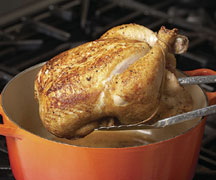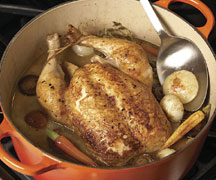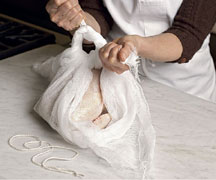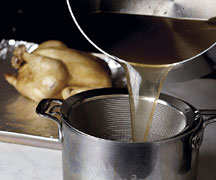Roast Chicken Move Over!
By Alice Osborne
A recent issue of Fine Cooking Magazine had a really inspiring article by Lisa Weiss on cooking whole chicken. When most of us think about cooking a whole chicken, we think about roasting the bird in the oven until the skin is golden and crisp, right?
But Lisa explained that as a cook who has become somewhat bored with roast chicken (and on more than one occasion been disappointed by a dried-out bird), she wanted to explore some other options. So she asked three experienced chefs if they would share a favorite cooking method for whole chicken - one that's tender, moist, full of flavor, and not roasted. Here's what they shared with her:
 Chef #1: Pam Mazzola of Prospect Restaurant in San Francisco, suggested cooking the chicken with spring vegetables, an elegant adaptation of a dish her grandmother used to make.
Chef #1: Pam Mazzola of Prospect Restaurant in San Francisco, suggested cooking the chicken with spring vegetables, an elegant adaptation of a dish her grandmother used to make.
Her favorite technique is braising. Pam browns the chicken and then slowly cooks it along with aromatic vegetables, broth, and wine. The low heat tenderizes the chicken by slowly and gently breaking down the fibers in the meat, while the liquid in the pot helps keep it juicy. Unlike her grandmother, who made a similar recipe by just putting everything in the pot to start, Pam browns the bird and sautés the vegetables separately, which creates a depth of flavor and richness that belies the dish's homey nature.


1. Browning the chicken before braising adds flavor and makes it look good, too. Sear it well on each side, turning it with a sturdy pair of tongs.
2. The vegetables, which are browned separately, are added to the pot after the chicken has cooked for a while in broth and wine. Use a spoon to distribute them evenly.
3. The braising liquid, strained and then boiled to intensify flavors, makes a light sauce for the tender chicken and vegetables.
 Chef #2: Barbara Lynch likes to wrap a whole vegetable-stuffed chicken in buttery pastry dough. She envelopes an entire bird in a buttery dough to form a crust (not unlike a salt crust) that allows the chicken to gently steam in its own juice, which is made even more flavorful thanks to an aromatic stuffing of rosemary, carrot, onion, and celery. Best of all, the dough bakes up buttery and flaky yet sturdy. It's scrumptious broken into pieces and eaten along with the chicken and vegetables.
Chef #2: Barbara Lynch likes to wrap a whole vegetable-stuffed chicken in buttery pastry dough. She envelopes an entire bird in a buttery dough to form a crust (not unlike a salt crust) that allows the chicken to gently steam in its own juice, which is made even more flavorful thanks to an aromatic stuffing of rosemary, carrot, onion, and celery. Best of all, the dough bakes up buttery and flaky yet sturdy. It's scrumptious broken into pieces and eaten along with the chicken and vegetables.
Prepare your favorite stuffing - adding chopped fresh vegetables - and stuff the well-cleaned cavity of your bird. Then prepare your favorite pie crust or pastry dough and:


1. Wrap the chicken as you would a present: Put it on the dough breast side down and bring up each side of the dough, overlapping it. If there is a lot of overlap, trim some away, then pinch the seams to seal.
2. Turn the wrapped bird over so the seams are on the bottom and the breast side is up. Brush with egg wash to help create a beautiful golden-brown crust and sprinkle with salt to bring out the dough's buttery flavor.
3. Carve as you would a roast chicken, slicing into the breast and pulling away the meat and crust. The legs should easily pull away, too. And don't forget to spoon out and serve the tasty vegetable stuffing.
 And Chef #3: Lidia Bastianich, renowned Italian chef, suggested a simple one-pot dish of perfectly poached chicken and vegetables that's served with a piquant and colorful salsa - Salsa Rustica.
And Chef #3: Lidia Bastianich, renowned Italian chef, suggested a simple one-pot dish of perfectly poached chicken and vegetables that's served with a piquant and colorful salsa - Salsa Rustica.
Lidia submerges a whole chicken in a broth full of earthy and fragrant ingredients, including porcini, celery root, and fennel. She adds even more flavor by stuffing the chicken with lemon and garlic before wrapping it in cheesecloth, which keeps the aromatics inside the bird and makes handling it easier. Her Salsa Rustica she serves the chicken with is made with capers, red onion, and fresh herbs, which provides the juicy yet pale chicken with a little color and a big kick of flavor.


1. Tie the chicken up in cheesecloth so it can absorb the flavors of the broth and be easily retrieved after it's been poached to fall-apart tenderness.
2. You'll serve some of the rich broth with the chicken, but the rest can be used for soup or saved for use in other recipes.
Lisa tried all three ideas and was impressed by just how tender the meat, both dark and white, cooked up for all three birds. She also loved that the recipes were forgiving. Unlike a roast chicken, which can quickly overcook in a hot oven, these approaches offered more flexibility in the cooking time. And since these recipes all use various moist-heat cooking methods, there's little risk of the meat drying out.
The question I had, though, was "What about the absence of that yummy herbed crispy chicken skin that you get when the bird is perfectly roasted" which none of these techniques could deliver? Instead, Lisa said she was so pleased with the supple meat and vegetables from all three dishes that she didn't miss that crispy skin a bit.
Put these techniques on your must-try list. It'll be a tasty and exciting experience, going beyond roast chicken!

